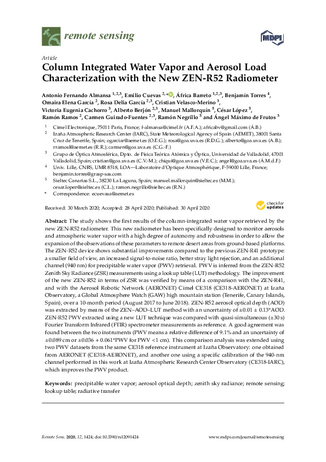The study shows the first results of the column-integrated water vapor retrieved by the new ZEN-R52 radiometer. This new radiometer has been specifically designed to monitor aerosols and atmospheric water vapor with a high degree of autonomy and robustness in order to allow the expansion of the observations of these parameters to remote desert areas from ground-based platforms. The ZEN-R52 device shows substantial improvements compared to the previous ZEN-R41 prototype: a smaller field of view, an increased signal-to-noise ratio, better stray light rejection, and an additional channel (940 nm) for precipitable water vapor (PWV) retrieval. PWV is inferred from the ZEN-R52 Zenith Sky Radiance (ZSR) measurements using a lookup table (LUT) methodology. The improvement of the new ZEN-R52 in terms of ZSR was verified by means of a comparison with the ZEN-R41, and with the Aerosol Robotic Network (AERONET) Cimel CE318 (CE318-AERONET) at Izaña Observatory, a Global Atmosphere Watch (GAW) high mountain station (Tenerife, Canary Islands, Spain), over a 10-month period (August 2017 to June 2018). ZEN-R52 aerosol optical depth (AOD) was extracted by means of the ZEN–AOD–LUT method with an uncertainty of ±0.01 ± 0.13*AOD. ZEN-R52 PWV extracted using a new LUT technique was compared with quasi-simultaneous (±30 s) Fourier Transform Infrared (FTIR) spectrometer measurements as reference. A good agreement was found between the two instruments (PWV means a relative difference of 9.1% and an uncertainty of ±0.089 cm or ±0.036 + 0.061*PWV for PWV <1 cm). This comparison analysis was extended using two PWV datasets from the same CE318 reference instrument at Izaña Observatory: one obtained from AERONET (CE318-AERONET), and another one using a specific calibration of the 940-nm channel performed in this work at Izaña Atmospheric Research Center Observatory (CE318-IARC), which improves the PWV product.
Title
Column Integrated Water Vapor and Aerosol Load Characterization with the New ZEN-R52 Radiometer
Authors
Almansa, A.F.; Cuevas, E.; Barreto, Á.; Torres, B.; García, O.E.; Delia García, R.; Velasco-Merino, C.; Cachorro, V.E.; Berjón, A.; Mallorquín, M.; López, C.; Ramos, R.; Guirado-Fuentes, C.; Negrillo, R.; de Frutos, Á.M.
Published
by Remote Sensing (RS) at 2020-04-20
Abstract
